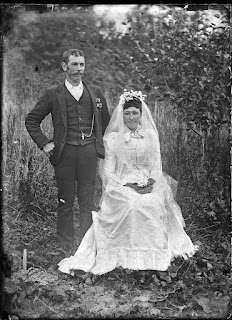Colonial Tinder
Matrimonial agencies and personal ads were the colonial era equivalent of today’s dating apps like Tinder. In 1885 the owner of Auckland’s only agency, Thomas Hannaford, claimed to have found 115 wives for socially isolated men. He was particularly proud of encouraging “many respectable English girls to wed Maori Chiefs” who were subsequently “living lovingly together”. He felt his match-making skills helped promote “the fusion of the races” and he petitioned Parliament to recognise his expertise in this area (Star, 16 July 1885).
Hannaford started finding potential life partners for gentlemen in 1868. He also married people at “any day or hour they like.” His Queen Street offices were open for business between 10.00 am and 9.00 pm. Although scandal didn’t brew over such quickie marriage ceremonies here; in Australia, Holt’s Matrimonial Agency was known to marry “under age teenagers without permission, bigamists or some even so drunk that they didn’t realise that they were getting married.”
The Tuapeka Times published an article on behalf of the Salvation Army stating they helped join young people who might otherwise “miss the blessings that go with double harness” due to a lack of social opportunities (30 April 1910). Typical ads for Hannaford’s include the virtues a woman might bring to a relationship such as a farmer’s daughter who could “cook, sew, milk, make butter, rear poultry, make bread and cheese, and just sings at her work (Observer, 18 January 1890)."
Prospective wives were variously described as devoted, reputable or valuable - especially if they had “means”, as some widows did. Men were described as worthy, respectable or reputable farmers, settlers or storekeepers. A good income and steady employment were prized for men – rather than their poultry-rearing skills. Mention of physical appearances might extend to “good-looking”, but being industrious was highly valued.
Mr Hannaford said he refused to “matrimonially ally” anyone who was feeble in health or did not have a respectable character. By 1890 he claimed to have brought together 180 couples, and he began a newspaper column in the Observer - “Cupid’s Corner” – aimed at bachelors, spinsters, widows and widowers. However, he died that year and soon after further agencies opened in Auckland.
Personal ads were also popular as in this example - two Bachelors “beg to inform Maggie Black and Flora Macdonald that they are still desirous of achieving matrimonial bliss.” If the women felt the same way, they were to write to “Cupid” at the newspaper’s offices (Tuapeka Times, 6 June 1872).
A typical personal ad in colonial NZ might be “A Gentleman (Sheep Farmer), of quiet habits” wishing to meet a young lady who was “well educated and of a sunny disposition” with a view to matrimony (Auckland Star, 27 August 1897). Or a young lady, domesticated, wishing to correspond with a young man with a view to matrimony (NZ Herald, 2 February 1900).
The Observer compared these genteel advertisements with more forthright Australian ads such as “Young Man would like to correspond with a nice young Scotch woman (no flirts)” and “English Lady, recent arrival, of good family… wishes to correspond with Gentleman… No beer barrels need apply” (14 November 1891).
Author: Leanne, Central Auckland Research Centre
Prospective wives were variously described as devoted, reputable or valuable - especially if they had “means”, as some widows did. Men were described as worthy, respectable or reputable farmers, settlers or storekeepers. A good income and steady employment were prized for men – rather than their poultry-rearing skills. Mention of physical appearances might extend to “good-looking”, but being industrious was highly valued.
The Observer compared these genteel advertisements with more forthright Australian ads such as “Young Man would like to correspond with a nice young Scotch woman (no flirts)” and “English Lady, recent arrival, of good family… wishes to correspond with Gentleman… No beer barrels need apply” (14 November 1891).






Comments
Post a Comment
Kia ora! Please leave your comment below.